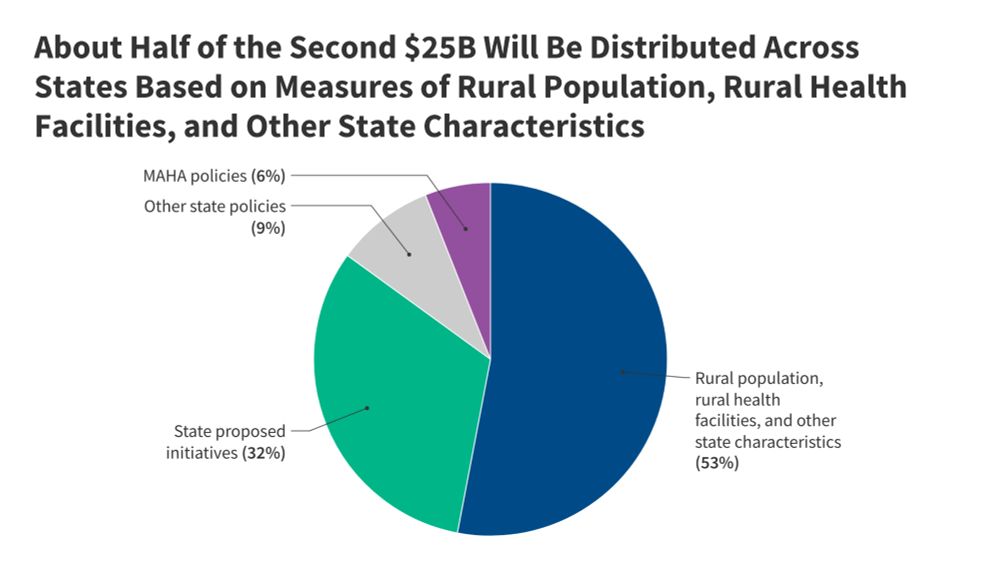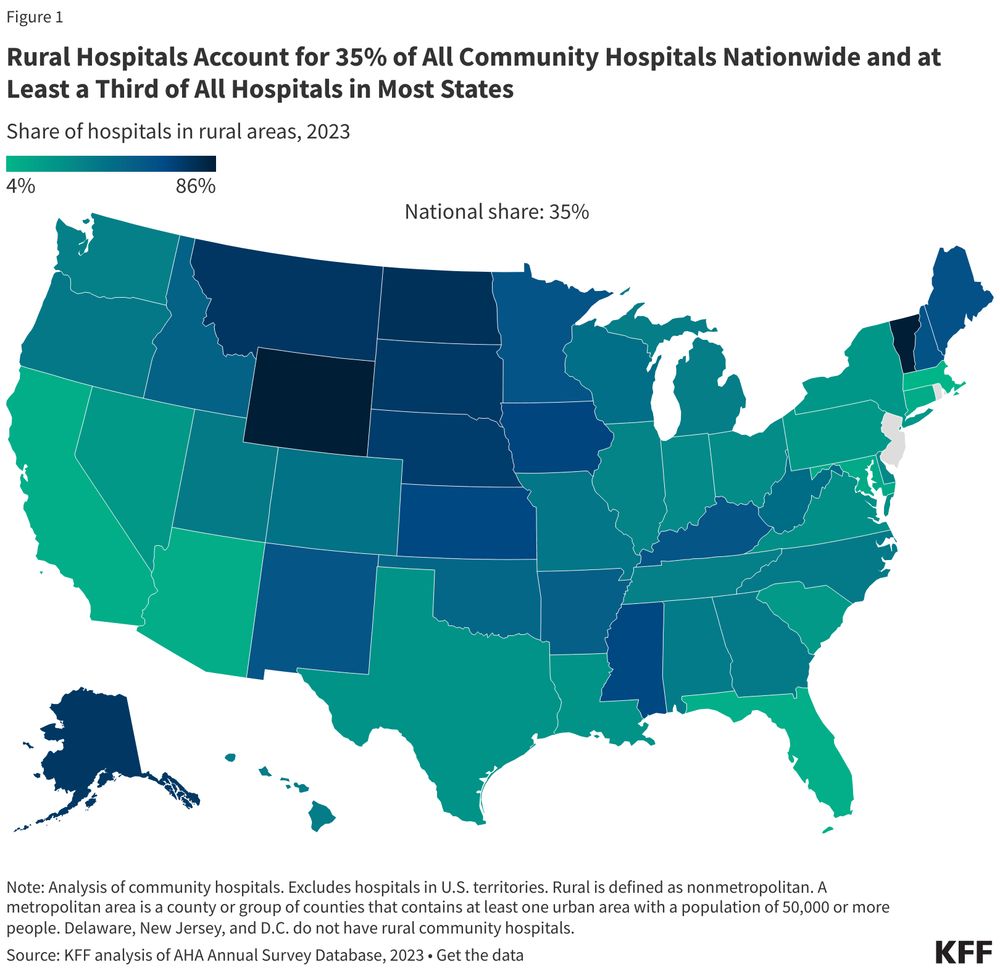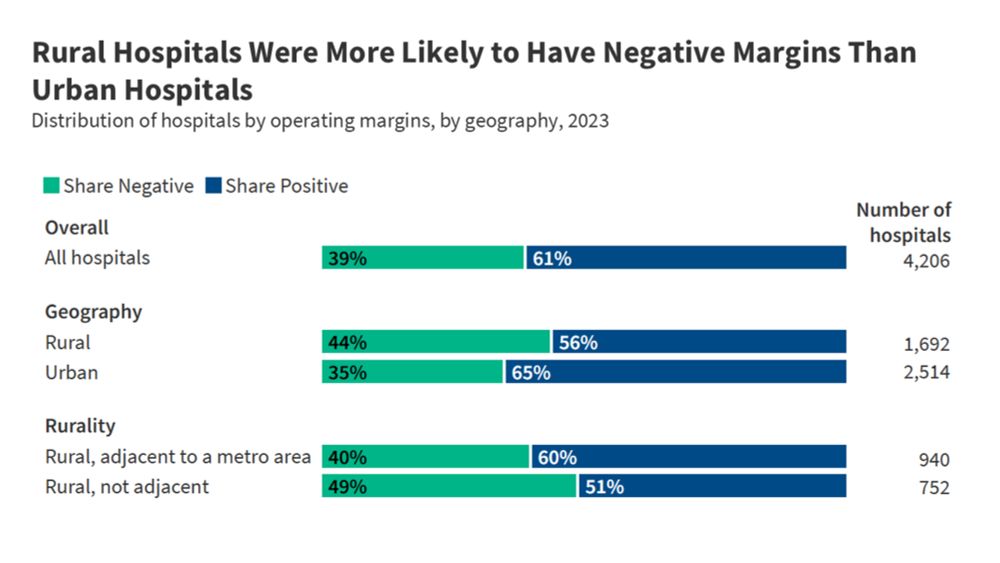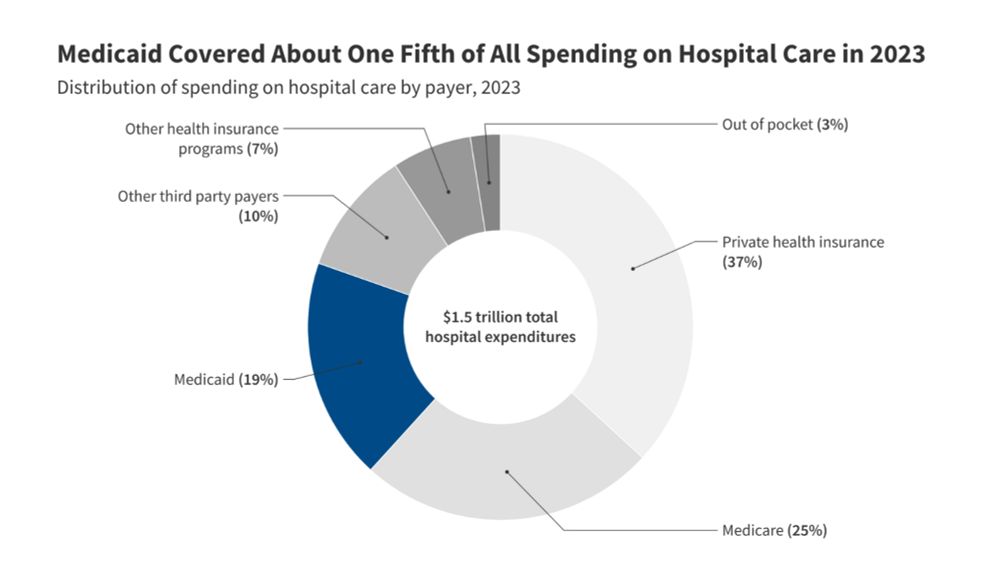CMS will decide which states to fund by the end of the year, and how to allocate the first year of funding across states. It is not yet clear how states will distribute funds across rural hospitals, other providers, and other state initiatives (9/9)
10.11.2025 19:50 — 👍 1 🔁 0 💬 0 📌 0
The analysis could not factor in the $12.5 billion that will be distributed based on CMS’s discretionary scoring of state policy, state initiatives, and other factors (8/9).
10.11.2025 19:50 — 👍 0 🔁 0 💬 1 📌 0

TX, CA, NM, MT, and AK are estimated to receive the largest amounts from the $37.5 billion. Most of the extra dollars they're estimated to receive are due to their large land area, one of several factors used to allocate funds based on state need (7/9).
10.11.2025 19:50 — 👍 1 🔁 0 💬 1 📌 0

Additionally, of the $12.5 billion based on measures of need, only 20% is directly based on total rural population (6/9).
10.11.2025 19:50 — 👍 1 🔁 0 💬 1 📌 0
This in part reflects the fact that estimated state awards vary much less than differences in rural populations, principally due to the equal distribution of the first $25 billion across all states with approved applications (5/9).
10.11.2025 19:50 — 👍 0 🔁 0 💬 1 📌 0

Estimated awards from the $37.5B are partially, but not closely, tied to rural population. E.g., TX has the most rural residents in the nation (4.3M) but is estimated to only receive about twice as much as RI, which has the fewest (about 25,000) (4/9)
10.11.2025 19:50 — 👍 1 🔁 0 💬 1 📌 0

Estimated awards from the $37.5B range from $550 million in Rhode Island to just over $1 billion in Texas over five years if all states are approved for funding (3/9).
10.11.2025 19:50 — 👍 0 🔁 0 💬 1 📌 0

The analysis examines $37.5B of the $50B fund: $25B to be distributed equally across states with approved applications (as required by law) and an additional $12.5B to be distributed based on measures of state need (as specified primarily by CMS) (2/9).
10.11.2025 19:50 — 👍 0 🔁 0 💬 1 📌 0

Key Takeaways from CMS's Rural Health Funding Announcement | KFF
This brief describes five key takeaways from CMS's Notice of Funding Opportunity for the $50 billion Rural Health Transformation Program. It includes information about how CMS intends to review state ...
New KFF brief examines CMS's recent rural health fund announcement. While the $50B fund could help rural areas in a number of ways, it's unclear the extent to which it will benefit rural hospitals and offset their losses under the reconciliation law. More from the brief: www.kff.org/other-health...
25.09.2025 18:55 — 👍 1 🔁 1 💬 0 📌 0
With today's announcement, it still remains to be seen how much of the $50 billion rural health fund will go to hospitals. According to CMS, payments to providers for care "cannot exceed 15% of the total" though other uses, like capital investments, could also benefit hospitals.
15.09.2025 19:04 — 👍 9 🔁 6 💬 0 📌 0

Five Things to Know About Medicare Site-Neutral Payment Reforms | KFF
This brief examines key facts around proposals to align Medicare payments for outpatient services across care settings, otherwise known as “site-neutral payment reforms.”
CMS just released its 2026 proposed rule for hospital outpatient payments. Among its proposals: lowering reimbursement for drug administration services at hospitals to the physician reimbursement rate.
Check out our brief to learn more about site neutral policies. www.kff.org/medicare/iss...
15.07.2025 21:18 — 👍 1 🔁 1 💬 0 📌 0

Urban hospitals that serve a large share of Medicaid patients have been left out of the conversation and without support from the fund, though many are already in the red. These hospitals could also have a hard time absorbing any losses under the bill (4/7)
27.06.2025 18:50 — 👍 2 🔁 1 💬 1 📌 0
The relief for hospitals and other providers would also be temporary, while major Medicaid and ACA cuts would be permanent (3/7).
27.06.2025 18:50 — 👍 2 🔁 1 💬 1 📌 0
It's unclear:
* How much of this fund would be used for hospitals,
* Which hospitals would be targeted, and
* Whether the fund would be enough to offset any losses for hospitals and other providers under the bill. (2/7).
27.06.2025 18:50 — 👍 2 🔁 0 💬 1 📌 0

One of the biggest flashpoints for the "One Big Beautiful Bill Act" has been its impact on roughly 1800 rural hospitals, which is why Senate Republicans are proposing a new $15 billion rural health fund. However, there are still questions and concerns about the bill 👇 (1/7)
27.06.2025 18:50 — 👍 12 🔁 10 💬 1 📌 0

New: New: Many rural hospitals are struggling. But, less so in states that have expanded Medicaid under the ACA.
www.kff.org/health-costs...
16.04.2025 14:22 — 👍 52 🔁 19 💬 0 📌 3

Medicaid covers about one-fifth of all hospital spending. There's a hospital in pretty much every Congressional district, and it's often one of the biggest employers.
www.kff.org/medicaid/iss...
05.03.2025 15:49 — 👍 225 🔁 100 💬 5 📌 5

Operating margins varied across states, which could reflect a variety of unique circumstances facing hospitals across the country, such as demographics, hospital ownership and cost structure, commercial reimbursement rates, and state and local health and tax policy.
18.12.2024 23:42 — 👍 2 🔁 1 💬 1 📌 0
Policymakers have explored options to rein in commercial prices. This analysis suggests that hospitals with the highest prices and largest commercial shares as a group are in a better position to absorb restraints on prices, though the impact would vary across hospitals.
18.12.2024 23:42 — 👍 1 🔁 0 💬 1 📌 0

Operating margins were also higher than average among hospitals with high prices, especially among those that also had high commercial shares.
18.12.2024 23:42 — 👍 1 🔁 0 💬 1 📌 0

In contrast to rural and high Medicaid share hospitals, operating margins were higher than average among hospitals with a relatively large share of commercial patients, system-affiliated hospitals, and (especially) for-profit hospitals.
18.12.2024 23:42 — 👍 1 🔁 0 💬 1 📌 0
Health policy analyst @KFF.org focusing on hospital access, affordability, and costs. Paw-rent 🐶, nature lover, board game enthusiast. They/them
Primary care physician/health policy research @yaleschoolofmed.bsky.social; @ncspyale.bsky.social; healthy skeptic; @jama.com deputy editor; open science: YODAProject @yalecrrit.bsky.social @medrxivpreprint.bsky.social
Economist at Carnegie Mellon focusing on organizations and incentives, markets, competition, and antitrust, and health care. Formerly at the Antitrust Division, DOJ and at the FTC. Daf Yomi learner. Antitrust, Economics, Talmud puns.
Producer, @armandalegshow.bsky.social. Lover of healthcare reporting, puns, & Oxford commas.
Subscribe to "First Aid Kit" at https://firstaidkit.substack.com/
@KFF.org EVP, COO & Exec Director, Public Opinion & Survey Research
KFF Health News partnerships editor. Other media outlets can use KFF Health News stories for free under these guidelines: https://kffhealthnews.org/syndication/
Surgeon, Writer ("Being Mortal," "Checklist Manifesto"), and formerly led Global Health @USAID.
Executive Director, Families USA.
Longtime health care consumer advocate working to make health care & coverage more accessible and affordable, and for health & economic security & justice, for all.
Views my own. Go Yankees, Kings, Mammoths, and Sagehens.
Educator, Author of The Daycare Myth: What We Get Wrong About Early Care and Education (and What We Should Do About It)
Senior Fellow at the American Enterprise Institute. Partner, New Enterprise Associates. Contributor CNBC. 23rd Commissioner of the U.S. FDA. Public boards: Pfizer, Illumina, TempusAI.
Mathematician, writer, Cornell professor. All cards on the table, face up, all the time. www.stevenstrogatz.com
Former Member of President Obama’s Council of Economic Advisers & Chief Economist at Labor. Current academic economist at Michigan. Always an economist at home.
Founder, Aledade
Former National Coordinator for Health IT
NYC Health Dept/ CDC EIS Officer
Senior Communications Officer at KFF, ex-reporter at The Washington Post and The Dallas Morning News, teller of Dad jokes.
Health policy, especially for stigmatized populations. Chief of health policy and econ at Weill Cornell and founding director of the Cornell Health Policy Center (CHPC).
Health economist, SDOH financing focus, New Orleans resident, fan of St.Louis Cardinals and New Orleans Saints.
Associate Director Global Health and Public Health Policy @KFF.
U.S. and international public health, infectious disease epidemiology, global health security.
Senior Researcher at KFF focused on #PublicHealth and #HealthPolicy. Tracking critical KPIs on the US Health and Healthcare system #Access #Affordability #Wellbeing #QualityofCare #HealthSpending @ www.healthsystemtracker.org ❤️ #dataviz
Health policy analyst @kff.org posting about the ACA, affordability, and a bit of pop culture | Hopkins alum | Views own🏳️🌈
https://www.kff.org/person/matt-mcgough/




















